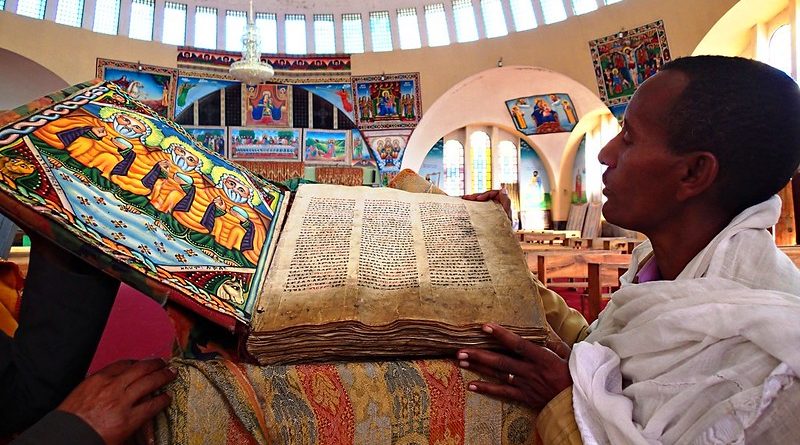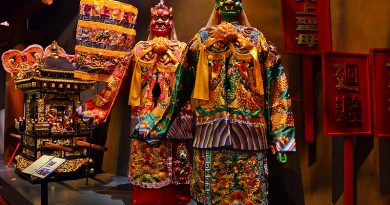Axum and the Ark of the Covenant
History Facts
When: 10 – 1 century BC
Where: North Ethiopia, East Africa
History: The hub of sophisticated Axumite Empire and the resting place of the Christian Ark of the Covenant
What to see: You won’t get a look at the sacred Ark, lest you internally combust in flames, but you can see precious objects and inscriptions of Ark lore
Holy History
Axum is a city with a rich history and a history of riches. Formed by a mainly Arabic community from the 10th to the 1st centuries BC, the Axumite Empire was controlling trade routes from Africa to Asia for nearly 1000 years and minting coins at a time when barely any other country was affluent or sophisticated enough to afford or require such business innovation. The history of Axum survives in stone inscriptions in the local Ge’ez language and ancient Greek. Greek geographers described Axum and its trade in ivory and slaves. The architecture of this period permeates all Ethiopia’s historic cities, such as Harar and Lalibela.
It was in Axum that King Ezna declared in the early 4th century that Christianity would be the official state religion. At that time he was head of the Zagwa Empire that controlled trade routes through the Port of Adulis, which is 40 miles south of Massawa in Eritrea. However, the true symbolic transfer of religious power preceded this political declaration by 1300 years, according to legend.
The Ark of the Covenant
The transfer of the Ark of the Covenant from Jerusalem to Axum is recounted in a medieval epic written in Ge’ez, “The Glory of Kings”. The Queen of Shebaheard heard of King Solomon’swisdom and travelled to Jerusalem to learn about his system of governance. Impressed by her intelligence and beauty, Solomon proceeded to beget a son by her even though they were unmarried; he said that he did it “to fill the earth with sons to serve the God of Israel”. Their son Menelik visits Solomon in Jerusalem as a young man, and is then appointed King of Ethiopia by his father. Solomon then instructs the elders of Israel to send their sons to serve as Menelik’s counsellors in Ethiopia (the origins of the Falasha, Ethiopian Jews). The young Israelites are so distressed to leave their holy homeland that they carry with them the Ark of the Covenant.
The likelihood of the ark residing in Ethiopia is a contentious subject. The ancient Armenian Abu Salih of Cairo wrote in Arabic that the Ethiopians possessed the Ark of the Covenant but he describes it as decorated with crosses, not a Jewish symbol. It’s possible that the wood would not have survived in the humid Ethiopian climate, but the stone tablets could have remained intact. The modern priests describe the Ark as a “sellat” which translates as tablet, rather than the word “tabot”, which could mean ark or tablet. The issue is further complicated by the fact that many people use the word “tabot” to describe the Ark in Axum, the Ark in the old testament and every altar tablet in every Ethiopian church. Ancient tablets have survived in Mecca for over 16 centuries; there’s no reason why the tablets could not be in Axum. The confusion ensues because the Ethiopian clergy believe that there could be more than one true Ark or Tablet, a theory which Hebrew and Greek versions of the bible can support. Each Ethiopian church altar, where the liturgy is read, is believed to be a replica of the Ark of the Covenant or the actual ancient Ark itself. In either case, it serves as a source of mystical inspiration, especially during the celebrations of Timkat (the Baptism of Christ) and Hedlar Seyon (the arrival of the Ark- November).
Sites of Interest
The Ark is guarded by a select group of celibate Monks in the St. Mary of Zion Church, in theChapel of the Tablet. Only one monk is allowed to view the ark (anyone else would burst into flames, according to legend) and he appoints a successor shortly before he dies. His duties include burning incense and reciting the book of Psalms to the Ark. There are two St. Mary of Zion churches in Axum: one, a square shaped former military centre built by King Fasilidas in the early seventeenth century houses a museum of crowns and jewels of former kings. The compound is forbidden to women, but the priests do carry the precious objects out of the forbidden area for viewing. The ruins of the original St. Mary of Zion lie close to the National Museum. It was built in the early fourth century, soon after the introduction of Christianity to Ethiopia. Haile Sellassie and Queen Elizabeth II of Britain built the most modern St. Mary of Zion in 1965.
The National Museum has examples of stones with Ge’ez and Sabean inscriptions and there is also a stone stele from the early 4th century dedicated to King Ezna which is near thePentaleon Monastery (which looks out over Axum to the distant mountains of Eritrea). The stele is uniquely inscribed with Ge’ez, Sabean, and Greek, exemplifying the ancient Ethiopian’s erudition and expansive trade.
When to Visit
Axum town is surrounded by dry hills with drab houses roofed with corrugated iron contrasting against the ruins of ancient monument – temples, fortresses, palaces, and churches. The best time to visit this small town is during the Timkat Festival – the Ethiopian Christmas (7th January), or the end of November during the Festival of Maryam Zion. If you happen to be in the town after a heavy rain, look under your feet; the rich civilization of the Axumite Empire resurfaces and buried hordes of gold, silver, and bronze coins are exposed through the shallow soil.
More information:
Ancient Horn of Africa: Axum
Photos of the UNESCO heritage site



